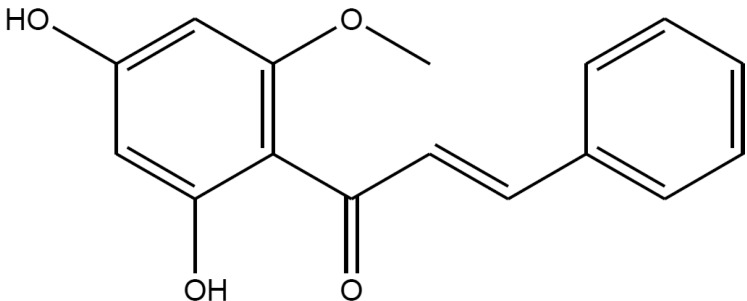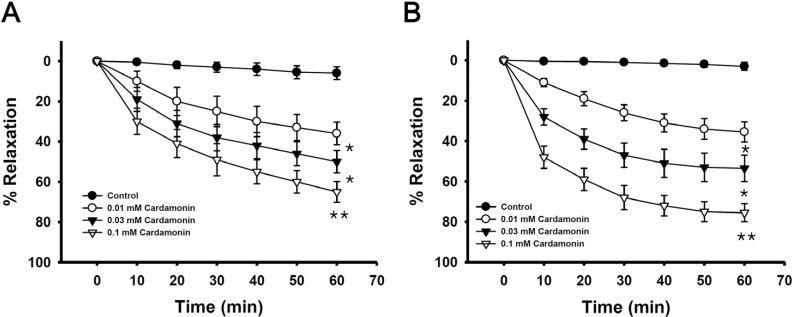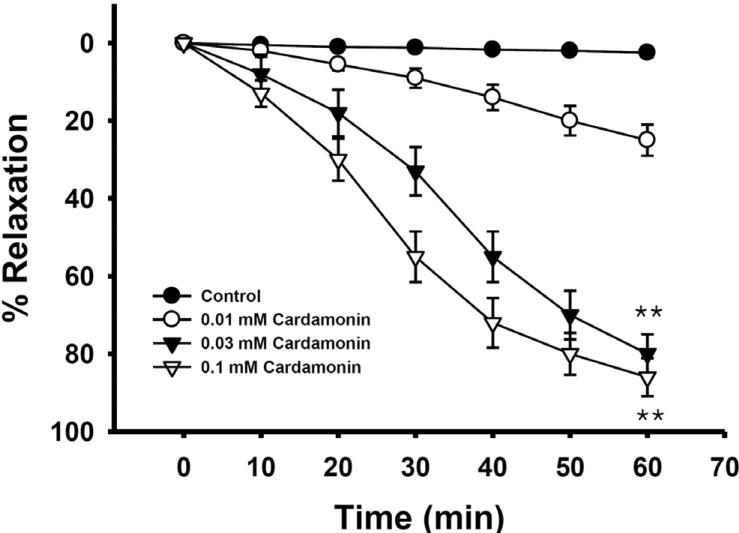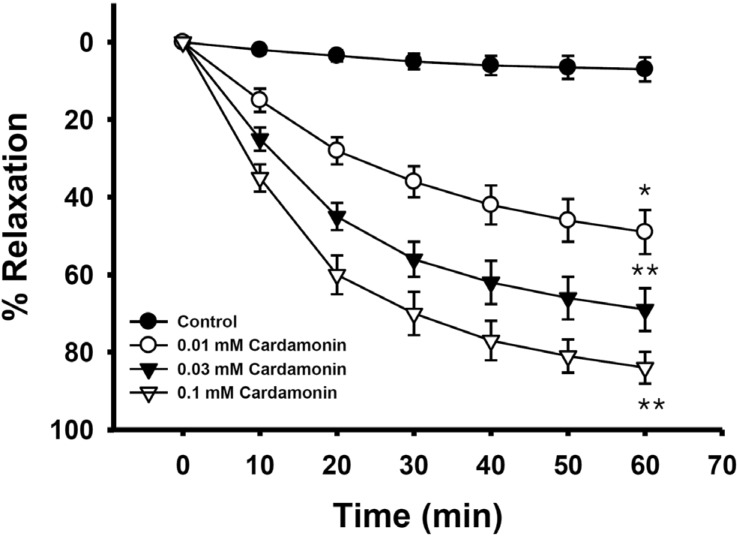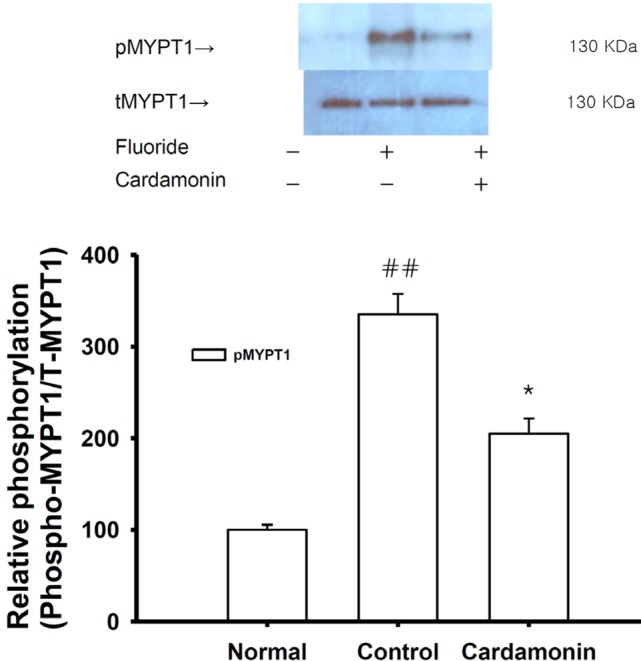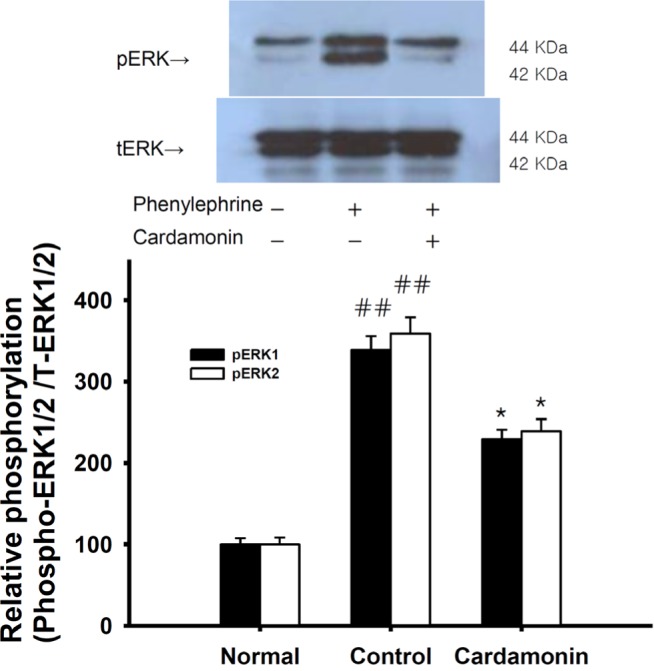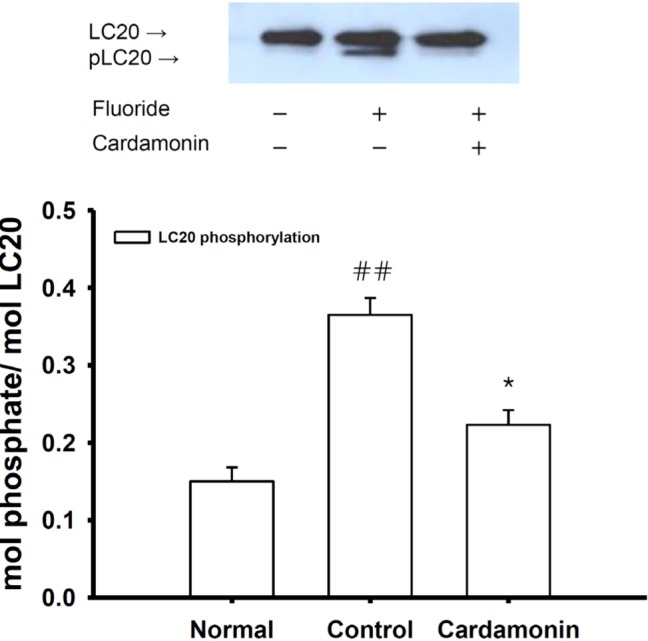Korean J Physiol Pharmacol.
2016 Jan;20(1):69-74. 10.4196/kjpp.2016.20.1.69.
Cardamonin inhibits agonist-induced vascular contractility via Rho-kinase and MEK inhibition
- Affiliations
-
- 1Department of Pharmacology, College of Pharmacy, Catholic University of Daegu, Gyeongsan 38430, Korea.
- 2College of Medicine, Chung-Ang University, Seoul 06974, Korea. jhjeong3@cau.ac.kr
- 3Research Institute for Translational System Biomics, Chung-Ang University, Seoul 06974, Korea.
- KMID: 2150475
- DOI: http://doi.org/10.4196/kjpp.2016.20.1.69
Abstract
- The present study was undertaken to investigate the influence of cardamonin on vascular smooth muscle contractility and to determine the mechanism(s) involved. Denuded aortic rings from male rats were used and isometric contractions were recorded and combined with molecular experiments. Cardamonin significantly relaxed fluoride-, phenylephrine-, and phorbol ester-induced vascular contractions, suggesting that it has an anti-hypertensive effect on agonist-induced vascular contraction regardless of endothelial nitric oxide synthesis. Furthermore, cardamonin significantly inhibited the fluoride-induced increase in pMYPT1 level and phenylephrine-induced increase in pERK1/2 level, suggesting inhibition of Rho-kinase and MEK activity and subsequent phosphorylation of MYPT1 and ERK1/2. This study provides evidence that the relaxing effect of cardamonin on agonist-induced vascular contraction regardless of endothelial function involves inhibition of Rho-kinase and MEK activity.
Keyword
MeSH Terms
Figure
Reference
-
1. Gonçalves LM, Valente IM, Rodrigues JA. An overview on cardamonin. J Med Food. 2014; 17:633–640. PMID: 24433078.
Article2. Chow YL, Lee KH, Vidyadaran S, Lajis NH, Akhtar MN, Israf DA, Syahida A. Cardamonin from Alpinia rafflesiana inhibits inflammatory responses in IFN-γ/LPS-stimulated BV2 microglia via NF-κB signalling pathway. Int Immunopharmacol. 2012; 12:657–665. PMID: 22306767.
Article3. Somlyo AP, Somlyo AV. Signal transduction and regulation in smooth muscle. Nature. 1994; 372:231–236. PMID: 7969467.
Article4. Somlyo AP, Somlyo AV. From pharmacomechanical coupling to G-proteins and myosin phosphatase. Acta Physiol Scand. 1998; 164:437–448. PMID: 9887967.
Article5. Uehata M, Ishizaki T, Satoh H, Ono T, Kawahara T, Morishita T, Tamakawa H, Yamagami K, Inui J, Maekawa M, Narumiya S. Calcium sensitization of smooth muscle mediated by a Rho-associated protein kinase in hypertension. Nature. 1997; 389:990–994. PMID: 9353125.
Article6. Sakurada S, Takuwa N, Sugimoto N, Wang Y, Seto M, Sasaki Y, Takuwa Y. Ca2+-dependent activation of Rho and Rho kinase in membrane depolarization-induced and receptor stimulation-induced vascular smooth muscle contraction. Circ Res. 2003; 93:548–556. PMID: 12919947.7. Kitazawa T, Masuo M, Somlyo AP. G protein-mediated inhibition of myosin light-chain phosphatase in vascular smooth muscle. Proc Natl Acad Sci U S A. 1991; 88:9307–9310. PMID: 1656467.
Article8. Wier WG, Morgan KG. Alpha1-adrenergic signaling mechanisms in contraction of resistance arteries. Rev Physiol Biochem Pharmacol. 2003; 150:91–139. PMID: 12884052.9. Kanaho Y, Moss J, Vaughan M. Mechanism of inhibition of transducin GTPase activity by fluoride and aluminum. J Biol Chem. 1985; 260:11493–11497. PMID: 2995338.
Article10. Blackmore PF, Exton JH. Studies on the hepatic calcium-mobilizing activity of aluminum fluoride and glucagon. Modulation by cAMP and phorbol myristate acetate. J Biol Chem. 1986; 261:11056–11063. PMID: 2426266.
Article11. Cockcroft S, Taylor JA. Fluoroaluminates mimic guanosine 5'-[gamma-thio]triphosphate in activating the polyphosphoinositide phosphodiesterase of hepatocyte membranes. Role for the guanine nucleotide regulatory protein Gp in signal transduction. Biochem J. 1987; 241:409–414. PMID: 3036062.12. Jeon SB, Jin F, Kim JI, Kim SH, Suk K, Chae SC, Jun JE, Park WH, Kim IK. A role for Rho kinase in vascular contraction evoked by sodium fluoride. Biochem Biophys Res Commun. 2006; 343:27–33. PMID: 16527249.
Article13. Wilson DP, Susnjar M, Kiss E, Sutherland C, Walsh MP. Thromboxane A2-induced contraction of rat caudal arterial smooth muscle involves activation of Ca2+ entry and Ca2+ sensitization: Rhoassociated kinase-mediated phosphorylation of MYPT1 at Thr-855, but not Thr-697. Biochem J. 2005; 389:763–774. PMID: 15823093.14. Wooldridge AA, MacDonald JA, Erdodi F, Ma C, Borman MA, Hartshorne DJ, Haystead TA. Smooth muscle phosphatase is regulated in vivo by exclusion of phosphorylation of threonine 696 of MYPT1 by phosphorylation of Serine 695 in response to cyclic nucleotides. J Biol Chem. 2004; 279:34496–34504. PMID: 15194681.
Article15. Goyal R, Mittal A, Chu N, Shi L, Zhang L, Longo LD. Maturation and the role of PKC-mediated contractility in ovine cerebral arteries. Am J Physiol Heart Circ Physiol. 2009; 297:H2242–H2252. PMID: 19749163.
Article16. Gu Z, Kordowska J, Williams GL, Wang CL, Hai CM. Erk1/2 MAPK and caldesmon differentially regulate podosome dynamics in A7r5 vascular smooth muscle cells. Exp Cell Res. 2007; 313:849–866. PMID: 17239373.
Article17. Kordowska J, Huang R, Wang CL. Phosphorylation of caldesmon during smooth muscle contraction and cell migration or proliferation. J Biomed Sci. 2006; 13:159–172. PMID: 16453176.
Article18. Tsai MH, Jiang MJ. Rho-kinase-mediated regulation of receptor-agonist-stimulated smooth muscle contraction. Pflugers Arch. 2006; 453:223–232. PMID: 16953424.
Article19. Ajay M, Gilani AU, Mustafa MR. Effects of flavonoids on vascular smooth muscle of the isolated rat thoracic aorta. Life Sci. 2003; 74:603–612. PMID: 14623031.
Article20. Taubert D, Berkels R, Klaus W, Roesen R. Nitric oxide formation and corresponding relaxation of porcine coronary arteries induced by plant phenols: essential structural features. J Cardiovasc Pharmacol. 2002; 40:701–713. PMID: 12409979.
Article21. Somlyo AP, Somlyo AV. Ca2+ sensitivity of smooth muscle and nonmuscle myosin II: modulated by G proteins, kinases, and myosin phosphatase. Physiol Rev. 2003; 83:1325–1358. PMID: 14506307.
- Full Text Links
- Actions
-
Cited
- CITED
-
- Close
- Share
- Similar articles
-
- Hypothermia Inhibits Endothelium-Independent Vascular Contractility via Rho-kinase Inhibition
- The Inhibitory Effect of Shikonin on the Agonist-Induced Regulation of Vascular Contractility
- Endothelium-Independent Effect of Fisetin on the Agonist-Induced Regulation of Vascular Contractility
- The Inhibitory Effect of Apigenin on the Agonist-Induced Regulation of Vascular Contractility via Calcium Desensitization-Related Pathways
- The Inhibitory Effect of Eupatilin on the Agonist-Induced Regulation of Vascular Contractility

